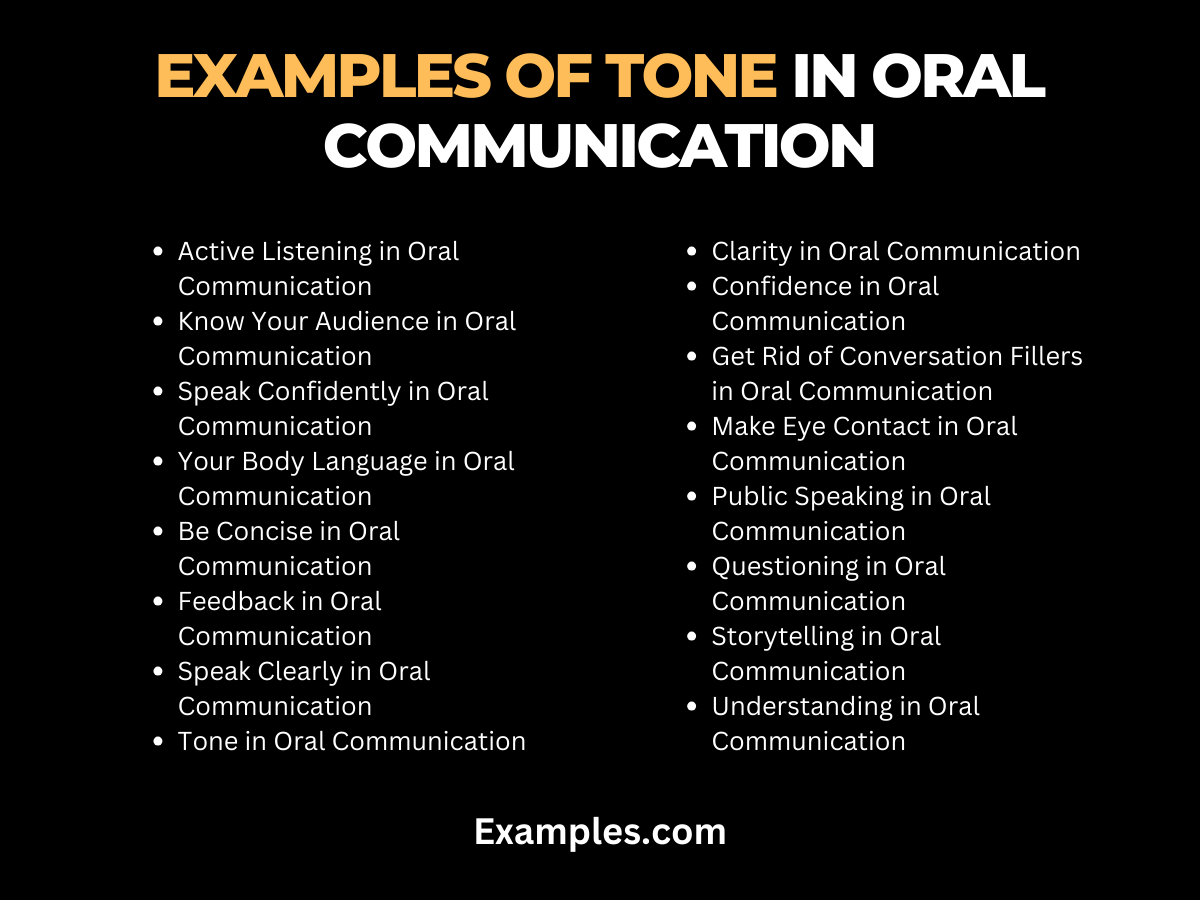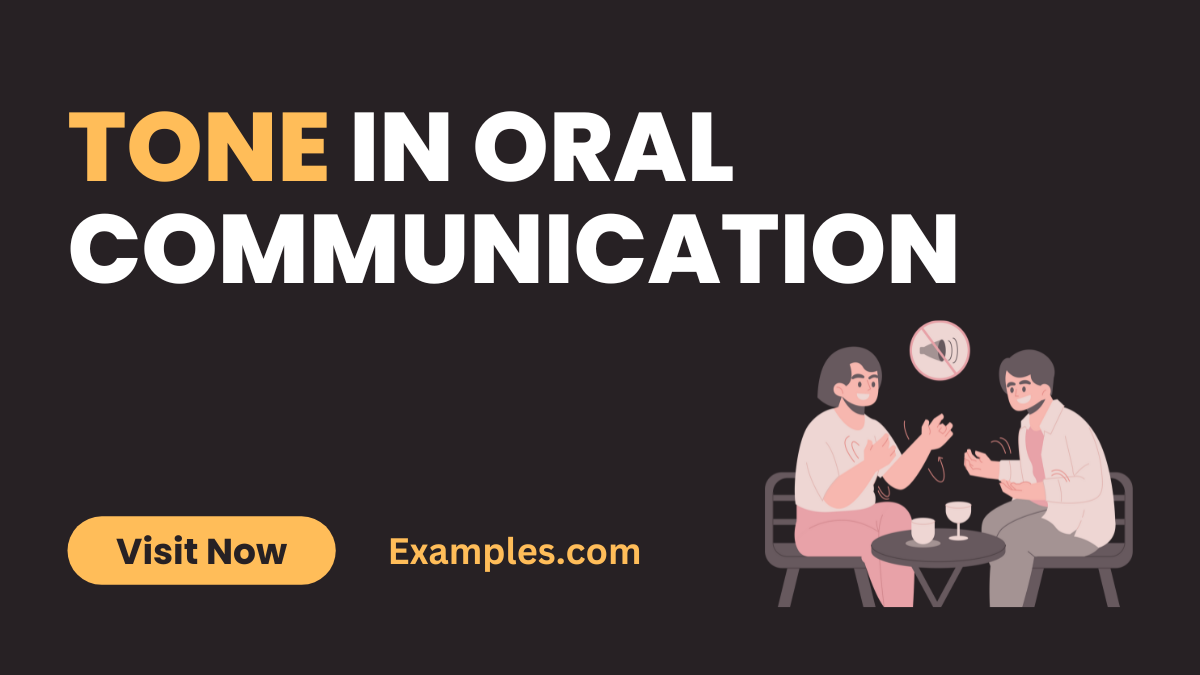19+ Tone in Oral Communication Examples
Understanding the Tone in Oral Communication is crucial for anyone seeking to improve their speaking skills. Whether in a professional setting, a classroom, or casual conversations, the tone of your voice can significantly impact how your message is received. This guide delves into the nuances of tone, offering valuable insights and practical tips to enhance your oral communication skills. Embrace the power of tone and transform the way you communicate!
What is the Tone in Oral Communication
Tone in Oral Communication refers to the vocal quality, emotion, and attitude conveyed through your voice when speaking. It’s not just about what you say, but how you say it. The tone can express a range of emotions, from enthusiasm and warmth to sarcasm and anger, influencing how your message is perceived. In oral communication, your tone can align with or contradict your words, making it a key element in effective communication.
What is the Best Example of Tone in Oral Communication
A classic example of tone in oral communication is a teacher’s voice in a classroom. Consider a scenario where a teacher is explaining a complex concept. If the teacher uses a warm, patient, and encouraging tone, it can foster an environment of comfort and openness, aiding in better understanding and active listening. Conversely, a harsh or impatient tone might lead to anxiety and misunderstanding, hindering effective learning. This example highlights the profound impact tone has on the effectiveness of communication in various settings.
20 Examples of Tone in Oral Communication

Active Listening in Oral Communication
Active listening involves fully concentrating on the speaker, understanding their message, and responding thoughtfully. It’s a key skill in effective communication.
Example: Nodding and saying “I understand what you mean” during a conversation.
Know Your Audience in Oral Communication
Understanding your audience’s needs, expectations, and background is crucial for effective communication. It helps in tailoring your message appropriately.
Example: Using technical jargon in a presentation to a group of experts in the field, but avoiding it with a general audience.
Speak Confidently in Oral Communication

Speaking with confidence helps in persuading and engaging your audience. Confidence in your tone and words can greatly impact the effectiveness of your message.
Example: Standing tall and using a steady, clear voice during a public speech.
Your Body Language in Oral Communication
Body language, including gestures, facial expressions, and posture, plays a significant role in reinforcing or contradicting your spoken words.
Example: Maintaining eye contact and an open stance while speaking to convey honesty and engagement.
Be Concise in Oral Communication
Clarity and brevity are key in oral communication. Being concise helps in delivering your message effectively without unnecessary details.
Example: Summarizing the main points at the end of a meeting.
Feedback in Oral Communication
Feedback, both giving and receiving, is essential for understanding and improvement in communication. It helps in gauging the effectiveness of your message.
Example: Asking for opinions after a presentation.
Think Before You Speak in Oral Communication
Taking a moment to organize your thoughts before speaking can prevent misunderstandings and errors. It’s important for clear and effective communication.
Example: Pausing briefly to formulate your response during a Q&A session.
Speak Clearly in Oral Communication
Clear articulation and avoiding mumbling are essential for being understood. Speaking clearly ensures your message is conveyed accurately.
Example: Pronouncing words distinctly during a phone call.
Tone in Oral Communication
The tone of your voice expresses your attitude and emotions, impacting how your message is received. A suitable tone can enhance understanding and engagement.
Example: Using a warm tone when greeting someone.
Avoid Clichés in Oral Communication
Using original language instead of clichés makes your communication more effective and engaging. It helps in conveying your message more clearly.
Example: Using specific examples instead of saying “think outside the box.”
Clarity in Oral Communication
Being clear in your communication helps in ensuring your message is understood as intended. Clarity avoids confusion and misinterpretation.
Example: Defining technical terms during a lecture to a non-specialist audience.
Confidence in Oral Communication
Exhibiting confidence in your speech influences how your message is perceived and can lead to greater persuasive power.
Example: Speaking with assurance about your project results in a team meeting.
Get Rid of Conversation Fillers in Oral Communication
Avoiding fillers like “um” and “uh” makes your communication more polished and professional. It enhances the clarity and flow of speech.
Example: Pausing briefly instead of using fillers when thinking.
Make Eye Contact in Oral Communication
Eye contact is a powerful tool in oral communication. It builds a connection with the audience, conveying sincerity and confidence.
Example: Making regular eye contact with different members of your audience during a presentation.
Open Mind in Oral Communication
Being open-minded in communication allows for a free exchange of ideas and shows respect for differing opinions.
Example: Actively listening and considering someone else’s perspective during a debate.
Public Speaking in Oral Communication
Public speaking involves addressing an audience in a structured, deliberate manner to inform, influence, or entertain.
Example: Delivering a keynote speech at a conference.
Questioning in Oral Communication
Effective questioning can guide a conversation and gather more information. It shows engagement and interest in the topic.
Example: Asking clarifying questions during a team discussion.
Storytelling in Oral Communication

Storytelling makes your communication more engaging and memorable. It helps in connecting with the audience on an emotional level.
Example: Sharing a personal experience to illustrate a point in a speech.
Tailoring Messages to Different Audiences
Adjusting your message based on the audience’s background, knowledge, and interests ensures better reception and understanding.
Example: Modifying the complexity of your language based on the age group you are addressing.
Understanding in Oral Communication
Demonstrating understanding in communication is about accurately interpreting and responding to the speaker’s message.
Example: Paraphrasing what someone has said to ensure you’ve understood correctly.
Importance of Tone in Oral Communication
- Reflects Emotion and Intent: The tone in oral communication helps convey emotions and intentions more accurately than words alone. It allows the listener to understand the underlying feelings behind a message.
- Builds Connections: A friendly and approachable tone fosters a sense of connection and trust between the speaker and the audience.
- Enhances Clarity: A clear and distinct tone makes it easier for the audience to grasp the message, thus improving understanding in oral communication.
- Influences Persuasiveness: The right tone can make an argument more convincing or a proposal more appealing, especially in public speaking in oral communication.
- Controls the Conversation Flow: An authoritative tone can command attention and manage the flow of conversation, especially in professional settings.
- Displays Confidence: A confident tone implies expertise and knowledge, which can be crucial in business or educational settings.
- Adjusts for Different Audiences: Tailoring the tone to suit the audience’s expectations and context can significantly enhance the effectiveness of the message.
- Mitigates Miscommunication: A well-moderated tone helps avoid misunderstandings that can occur due to ambiguous language or phrasing.
Tips to Improve Tone in Oral Communication
- Practice Active Listening: Understand the context and mood of the conversation. Active listening in oral communication helps adapt your tone accordingly.
- Be Mindful of Volume and Pitch: Adjust your volume and pitch to be neither too loud nor too soft. Ensure your voice is pleasant and not monotonous.
- Control Your Speed: Speaking too fast can be overwhelming, while too slow can be boring. Find a balanced speed that suits the context of the conversation.
- Use Pauses Effectively: Pauses can be powerful in adding emphasis and allowing your audience to digest your points.
- Work on Voice Modulation: Practice varying your tone to emphasize different parts of your message. This makes your communication more engaging.
- Record and Review: Record your speeches or conversations and critically review them to understand how you sound to others.
- Seek Feedback: Regular feedback from peers or mentors can provide insights into how your tone is perceived and areas for improvement.
- Be Emotionally Aware: Understand the emotional undertone of your message and ensure your tone aligns with it. This helps in conveying sincerity and authenticity.
Embracing the Full Spectrum of Tone in Communication: As we’ve explored, the tone in oral communication is a dynamic and powerful tool that can significantly influence the effectiveness of our interactions. By being aware and adaptable in our tonal choices, we can enhance our ability to connect with others, convey our messages more effectively, and create more meaningful relationships in both personal and professional settings. It’s not just about the words we choose, but how we choose to deliver them. A well-modulated tone can be the difference between a message that resonates and one that falls flat.
Further Exploration and Resources: For those eager to delve deeper into mastering tone in communication, exploring additional resources can be immensely beneficial. Educational platforms like Harvard Business Review offer insights on effective communication strategies in professional environments. Additionally, Toastmasters International, a renowned global organization dedicated to communication and leadership development, provides valuable resources and community support for those looking to refine their public speaking and communication skills. Engaging with these resources can provide you with a broader perspective and practical tools to elevate your communication prowess.



